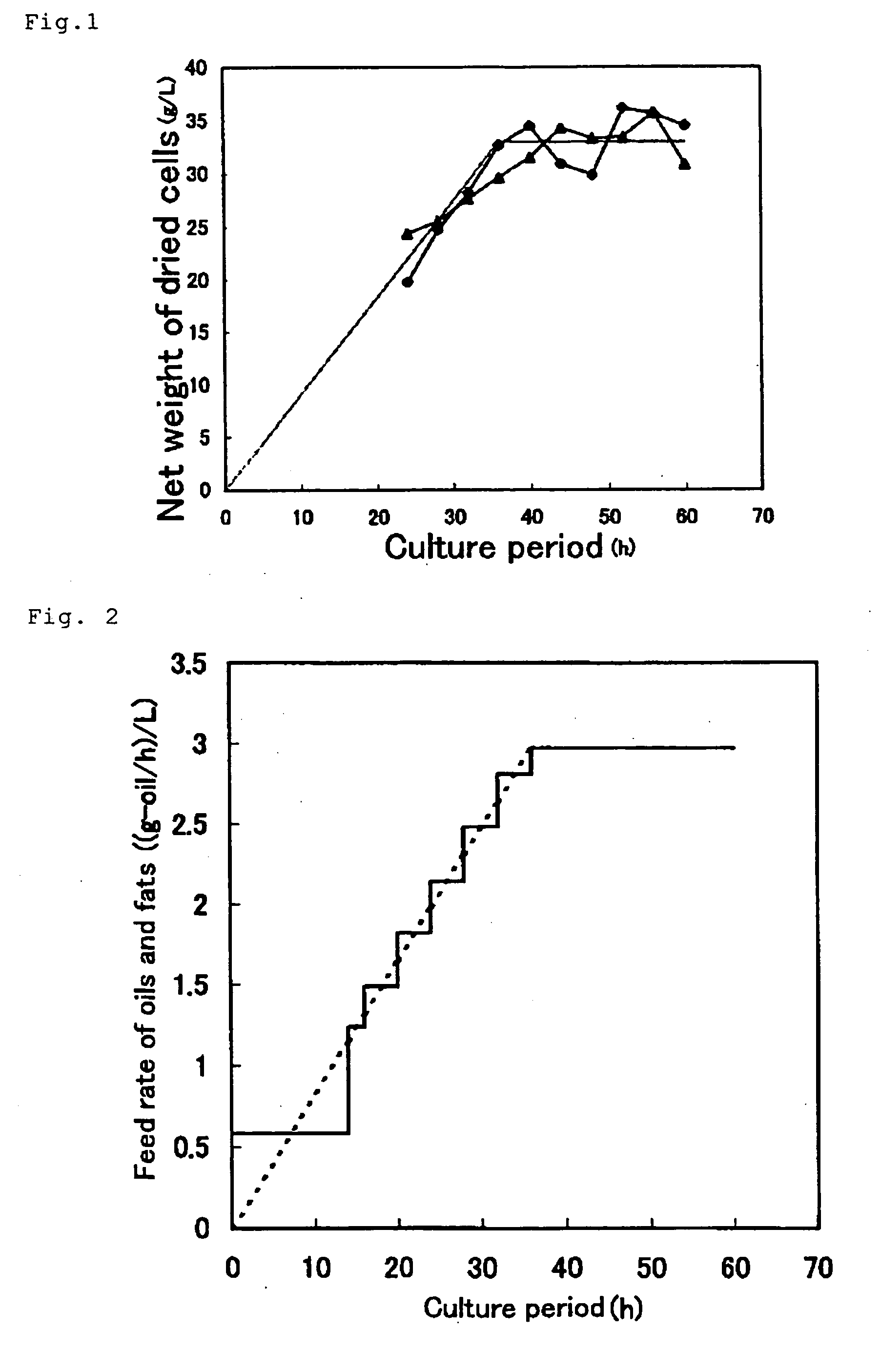Culture method of controlling the composition of copolymer polyester
a technology of copolymer polyester and copolyester, which is applied in the field of culture method for controlling the composition of copolyester, can solve the problems of limited practical application, inability to improve flexibility to such an extent, and inability to achieve the effect of high productivity and low cos
- Summary
- Abstract
- Description
- Claims
- Application Information
AI Technical Summary
Benefits of technology
Problems solved by technology
Method used
Image
Examples
example 1
[0051]Ralstonia eutropha strain PHB-4 / pJRDEE32d13 (T. Fukui., Y. Doi., Appl. Microbiol. Biotechnol., 49, 333-336 (1998)) (hereinafter, referred to briefly as “Red 13” strain) was cultured as follows. Incidentally, the Red 13 strain is deposited internationally to the National Institute of Advanced Industrial Science and Technology, International Patent Organism Depositary (Central 6, 1-1-1, Higashi, Tsukuba, Ibaraki, JAPAN) on the date of Aug. 7, 1997 under the name of Alcaligenes eutrophus AC 32 in an accession number of FERM BP-6038 under Budapest treaty.
[0052] The composition of the seed medium was made to comprise 1 w / v % Meat-extract, 1 w / v % Bacto-trypton, 0.2 w / v % Yeast-extract, 0.9 w / v % Na2PO4. 12H2O, 0.15 w / v % KH2PO4 and pH 6.8.
[0053] The composition of the preculture medium was made to comprise 1.1 w / v % Na2PO4. 12H2O, 0.19 w / v % KH2PO4, 1.29 w / v % (NH4)2SO4, 0.1 w / v % MgSO4. 7H2O, 2.5 w / v % palm W olein oil, 0.5 v / v % trace metal salt solution (1.6 w / v % FeCl3. 6H2O,...
example 2
[0064] A culture was carried out in the same medium and conditions as in Example 1 except that soybean oil was used instead of palm kernel olein oil. The results shown in Table 3 were obtained.
TABLE 3Specific substrateCultureCultureCultureCulturefeed rate24-h36-h48-h60-hP(3HB-co-3HH) produced (g / L)0.0823355620.0943960640.1034160683HH content (mol %)0.0813.26.75.34.10.0912.95.84.23.40.1013.84.93.33.2
[0065] As shown in Table 3, it was found that soybean oil, similarly to palm kernel olein oil, enhanced the 3HH content in polyester by controlling the specific substrate feed rate to be low. However, when the 3HH contents under the same conditions of the specific substrate feed rate were compared between soybean oil and palm kernel olein oil used in Example 1, the content was markedly lower in the case of soybean oil. Therefore, it was found that a difference in the 3HH content was caused by a difference of an oil or fat used as a substrate even when the specific substrate feed rate wa...
example 3
[0067] A culture was carried out in the same medium and conditions as in Example 1 except that corn oil, cotton seed oil, palm kernel oil, coconut oil, peanut oil and palm W olein oil were used instead of palm kernel olein oil and that the specific substrate feed rate were controlled at 0.06 (g; oil or fat)×(g; net weight of dried cells)−1×(hour)−1 and 0.12 (g; oil or fat)×(g; net weight of dried cells)−1×(hour)−1 for the respective oils. The results shown in Table 4 were obtained. Table 4 summarizes the influence of the specific substrate feed rate on the productivity of copolyester and the 3HH content for the respective oils (the results obtained at 60-hour culture were compared).
TABLE 4Specific substrateSpecific substratefeed rate 0.06feed rate 0.12P(3HB-co-3HH)3HHP(3HB-co-3HH)3HHproducedcontentproducedcontentOils and fats(g / L)(mol %)(g / L)(mol %)Corn oil63(g / L)3.2682.7Cottonseed oil483.3522.7Palm W olein603.3623oilPalm kernel oil457486.8Coconut oil4113.84313.5Peanut oil435.2454...
PUM
| Property | Measurement | Unit |
|---|---|---|
| temperature | aaaaa | aaaaa |
| temperature | aaaaa | aaaaa |
| temperature | aaaaa | aaaaa |
Abstract
Description
Claims
Application Information
 Login to View More
Login to View More - R&D
- Intellectual Property
- Life Sciences
- Materials
- Tech Scout
- Unparalleled Data Quality
- Higher Quality Content
- 60% Fewer Hallucinations
Browse by: Latest US Patents, China's latest patents, Technical Efficacy Thesaurus, Application Domain, Technology Topic, Popular Technical Reports.
© 2025 PatSnap. All rights reserved.Legal|Privacy policy|Modern Slavery Act Transparency Statement|Sitemap|About US| Contact US: help@patsnap.com

